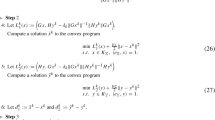Abstract
Principal angles between linear subspaces have been studied for their application to statistics, numerical linear algebra, and other areas. In 2005, Iusem and Seeger defined critical angles within a single convex cone as an extension of antipodality in a compact set. Then, in 2016, Seeger and Sossa extended that notion to two cones. This was motivated in part by an application to regression analysis, but also allows their cone theory to encompass linear subspaces which are themselves convex cones. One obstacle to computing the maximal critical angle between cones is that, in general, the maximum will not occur at a pair of generators of the cones. We show that in the special case where the maximal angle between the cones is nonobtuse, it does suffice to check only the generators. This special case can be checked at essentially no extra cost, and we incorporate that information into an improved algorithm to find the maximal angle.
Similar content being viewed by others
References
Afriat SN (1957) Orthogonal and oblique projectors and the characteristics of pairs of vector spaces. Math Proc Camb Philos Soc 52(4):800–816. https://doi.org/10.1017/S0305004100032916
Ben-Israel A (1969) Linear equations and inequalities on finite dimensional, real or complex, vector spaces: a unified theory. J Math Anal Appl 27(2):367–389. https://doi.org/10.1016/0022-247X(69)90054-7
Björck Å, Golub GH (1973) Numerical methods for computing angles between linear subspaces. Math Comput 27(123):579–594. https://doi.org/10.1090/S0025-5718-1973-0348991-3
Goldberg F, Shaked-Monderer N (2014) On the maximal angle between copositive matrices. Electron J Linear Algebra 27:837–850. https://doi.org/10.13001/1081-3810.2842
Golub GH, Loan CFV (2013) Matrix computations. The Johns Hopkins University Press, Baltimore
Gourion D, Seeger A (2010) Critical angles in polyhedral convex cones: numerical and statistical considerations. Math Program 123:173–198. https://doi.org/10.1007/s10107-009-0317-2
Gourion D, Seeger A (2011) Critical angles in random polyhedral cones. J Math Anal Appl 374(1):8–21. https://doi.org/10.1016/j.jmaa.2010.08.034
Gowda MS, Jeong J (2017) Commutation principles in Euclidean Jordan algebras and normal decomposition systems. SIAM J Optim 27(3):1390–1402. https://doi.org/10.1137/16M1071006
Gowda MS, Sznajder R, Tao J (2013) The automorphism group of a completely positive cone and its Lie algebra. Linear Algebra Appl 438:3862–3871. https://doi.org/10.1016/j.laa.2011.10.006
Hiriart-Urruty JB, Seeger A (2010) A variational approach to copositive matrices. SIAM Rev 52(4):593–629. https://doi.org/10.1137/090750391
Iusem A, Seeger A (2005a) Axiomatization of the index of pointedness for closed convex cones. Comput Appl Math 24(2):245–283. https://doi.org/10.1590/S0101-82052005000200006
Iusem A, Seeger A (2005b) On pairs of vectors achieving the maximal angle of a convex cone. Math Program 104(2–3):501–523. https://doi.org/10.1007/s10107-005-0626-z
Iusem A, Seeger A (2007a) Angular analysis of two classes of non-polyhedral convex cones: the point of view of optimization theory. Comput Appl Math 26(2):191–214. https://doi.org/10.1590/S0101-82052007000200002
Iusem A, Seeger A (2007b) On convex cones with infinitely many critical angles. Optimization 56(1–2):115–128. https://doi.org/10.1080/02331930600819985
Iusem A, Seeger A (2008a) Antipodal pairs, critical pairs, and Nash angular equilibria in convex cones. Optim Methods Softw 23(1):73–93. https://doi.org/10.1080/10556780701661427
Iusem A, Seeger A (2008b) Antipodality in convex cones and distance to unpointedness. Appl Math Lett 21(10):1018–1023. https://doi.org/10.1016/j.aml.2007.10.018
Iusem A, Seeger A (2009) Searching for critical angles in a convex cone. Math Program 120(1):3–25. https://doi.org/10.1007/s10107-007-0146-0
Miao J, Ben-Israel A (1992) On principal angles between subspaces in \(\mathbf{R}^{n}\). Linear Algebra Appl 171:81–98. https://doi.org/10.1016/0024-3795(92)90251-5
Obert DG (1991) The angle between two cones. Linear Algebra Appl 144:63–70. https://doi.org/10.1016/0024-3795(91)90061-Z
Peña J, Renegar J (2000) Computing approximate solutions for convex conic systems of constraints. Math Program 87(3):351–383. https://doi.org/10.1007/s101070050001
Ramírez H, Seeger A, Sossa D (2013) Commutation principle for variational problems on Euclidean Jordan algebras. SIAM J Optim 23(2):687–694. https://doi.org/10.1137/120879397
Rockafellar RT (1970) Convex analysis. Princeton University Press, Princeton
Seeger A (2014) Lipschitz and Hölder continuity results for some functions of cones. Positivity 18(3):505–517. https://doi.org/10.1007/s11117-013-0258-0
Seeger A, Sossa D (2016a) Critical angles between two convex cones I. General theory. TOP 24(1):44–65. https://doi.org/10.1007/s11750-015-0375-y
Seeger A, Sossa D (2016b) Critical angles between two convex cones II. Special cases. TOP 24(1):66–87. https://doi.org/10.1007/s11750-015-0382-z
Acknowledgements
The author thanks Alberto Seeger for taking the time to answer questions, and for his comments on a draft of this work.
Author information
Authors and Affiliations
Corresponding author
Additional information
Communicated by Jinyun Yuan.
Publisher's Note
Springer Nature remains neutral with regard to jurisdictional claims in published maps and institutional affiliations.
Rights and permissions
About this article
Cite this article
Orlitzky, M. When a maximal angle among cones is nonobtuse. Comp. Appl. Math. 39, 83 (2020). https://doi.org/10.1007/s40314-020-1115-y
Received:
Revised:
Accepted:
Published:
DOI: https://doi.org/10.1007/s40314-020-1115-y
Keywords
- Critical angle
- Maximal angle
- Nash angle
- Convex cone
- Polyhedral cone
- Principal angle
- Nonconvex optimization



